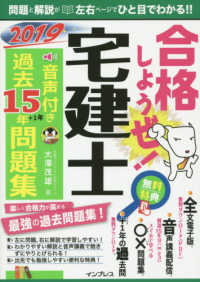- ホーム
- > 洋書
- > 英文書
- > Architecture
Full Description
Emotions and Architecture: Forging Mediterranean Cities Between the Middle Ages and Early Modern Time explores architecture as a medium to arouse or conceal emotions, to build consensus through shared values, or to reconnect the urban community to its alleged ancestry.
The chapters in this edited collection outline how architectonic symbols, images, and structures were codified - and sometimes recast - to match or to arouse emotions awakened by wars, political dominance, pandemic challenges, and religion. As signs of spiritual and political power, these elements were embraced and modulated locally, providing an endorsement to authorities and rituals for the community. This volume provides an overview of the phenomenon across the Italian region, stressing the transnationality of selected symbols and their various declinations in local contexts. It deepens the issue of refitting symbols, artworks, and structures to arouse emotions by carefully analysing specific cases, such as the Septizodium in Rome, the Holy House of Loreto in Venice, and the reconstruction of L'Aquila. The collection, through its variegated contributions, offers a comprehensive view of the phenomenon: exploring the issue from political, social, religious, and public health perspectives, and seeking to propose a new definition of architecture as a visual emotional language. Together, the chapters show how the representation of virtues and emotions through architecture was part of a symbolic practice shared by many across the Italian context.
This book will be of interest to researchers and students studying architectural history, the history of emotions, and the history of art.
Contents
Lists of figures
List of contributors
Preface
Francesca Lembo Fazio
Valentina Tomassetti
1. Fragments, spolia and remains. Emotional antiquities in Rome between the Early Modern and Renaissance era
Francesca Lembo Fazio
2. Spaces of Virtue. Transcultural Affection and its Representation in Ottoman-Venetian Relations
Luc Wodzicki
3. The Geopolitics of Simulacra and the Seventeenth-Century Venetian Holy House of Loreto
Liv Deborah Walberg
4. Mythmaking, Fidelity, and Urbanism in Early Modern Messina and Palermo
Tamara Morgenstern
5. Architecture and Emotions in Early Modern Quarantine Centres
Marina Inì
6. The rebuilding of L'Aquila after the 1703 quake: death and rebirth
Rossana Mancini
7. Identity Perception in Monuments, Ruins and Remains: Roman and Romano-British Heritage in British Travel Accounts c.1770-1820
Barbara Tetti
Index








